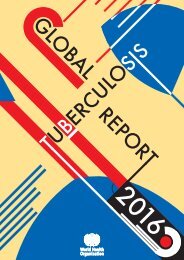patients
DNDi_AR_2015
DNDi_AR_2015
You also want an ePaper? Increase the reach of your titles
YUMPU automatically turns print PDFs into web optimized ePapers that Google loves.
R&D MODEL & PORTFOLIO<br />
with similar gene sequences to the<br />
parasites).<br />
In total over 17,000 compounds have<br />
been provided by the companies<br />
and organizations listed below,<br />
in addition to the commercial<br />
MicroSource library. This effort<br />
yielded a considerable number of<br />
hits in the low micromolar range.<br />
However, further work is needed to<br />
make optimized antifilarial drugs<br />
before progressing any candidate<br />
into preclinical development.<br />
Resources for this project are mainly<br />
dedicated to profiling molecules<br />
from the optimisation programmes<br />
undertaken by AbbVie and Celgene.<br />
PARTNERS: The Hospital of Bonn, Institute<br />
for Medical Microbiology, Immunology &<br />
Parasitology (IMMIP), Germany; the Muséum<br />
National d’Histoire Naturelle Paris, France;<br />
and the Northwick Park Institute for Medical<br />
Research (NPIMR), UK<br />
MAIN COMPOUND LIBRARIES: AbbVie,<br />
USA; AstraZeneca, UK; BASF, Germany;<br />
Bristol-Myers Squibb (BMS), USA; Celgene,<br />
USA; GSK, Tres Cantos, Spain; E.I. DuPont<br />
Nemours, USA; Epichem, Australia; Janssen,<br />
Belgium; Mercachem, The Netherlands;<br />
Merck, USA; Merck Serono, Germany; MMV,<br />
Switzerland; National Institutes of Health<br />
(NIH), USA; Novartis Centre de la Recherche<br />
Santé Animale, Switzerland; Sanofi, France;<br />
TB Alliance, USA; WuXi AppTech, China<br />
NTD Drug Discovery Booster to speed up compounds identification<br />
OVERALL OBJECTIVE: Speed up<br />
the process and cut the cost of finding<br />
new treatments for leishmaniasis and<br />
Chagas Disease<br />
OBJECTIVE 2015: Implement the NTD Drug<br />
Discovery Booster project<br />
with 3-6 pharmaceutical companies<br />
More than<br />
1,600<br />
analogues<br />
tested<br />
The NTD Drug Discovery<br />
Booster was launched in<br />
2015 as an experiment<br />
aimed at speeding up<br />
the process and cutting the cost of<br />
finding new treatments for Chagas<br />
disease and leishmaniasis. Initially,<br />
the project brought together DNDi<br />
and four pharmaceutical companies:<br />
Eisai Co Ltd, Shionogi & Co Ltd,<br />
Takeda Pharmaceutical Ltd, and<br />
AstraZeneca plc.<br />
The chemical universe around a DNDi lead<br />
molecule (red) is explored through sharing<br />
of molecules in pharma companies databases<br />
(green, cyan, yellow, purple spheres).<br />
DNDi supplies active “seed” compounds<br />
used by each company for in<br />
silico searches of chemical libraries<br />
for structurally-related compounds<br />
and entirely novel chemical scaffolds.<br />
The most interesting compounds are<br />
selected and undergo further testing<br />
in vitro to assess potency. In a<br />
multilateral, simultaneous search<br />
process across the pharmaceutical<br />
companies, DNDi accesses<br />
millions of compounds, generated<br />
over decades of research. Identification<br />
of novel chemical entities acts<br />
as a starting point for optimization<br />
of potential treatments or cures for<br />
these diseases. The innovation of the<br />
Drug Discovery Booster not only lies<br />
in the multilateral and cross-company<br />
comparative approach, but also in<br />
the iterative nature of the search, in<br />
which companies continue to examine<br />
their compound libraries for better<br />
compound matches as the search is<br />
refined. This will significantly reduce<br />
the time it will take to find new, promising<br />
treatment leads.<br />
NTD Drug Discovery Booster meeting in Tokyo<br />
with partners’ representatives, November 2015.<br />
By the end of 2015, six seed compounds<br />
had been submitted to the<br />
Booster for the first round of in silico<br />
screening and then the identified<br />
analogues were tested in vitro by the<br />
Institut Pasteur Korea and showed<br />
improvements in potency or the identification<br />
of novel chemical scaffolds.<br />
Further iterations will seek to build<br />
on these initial results.<br />
Celgene joined the consortium<br />
in 2016, and it is hoped that more<br />
companies will join in the future.<br />
PARTNERS: AstraZeneca, UK; Celgene, USA<br />
(since 2016); Eisai, Japan; Shionogi, Japan;<br />
Takeda Pharmaceutical, Japan<br />
DNDi Annual Report 2015 › 21



